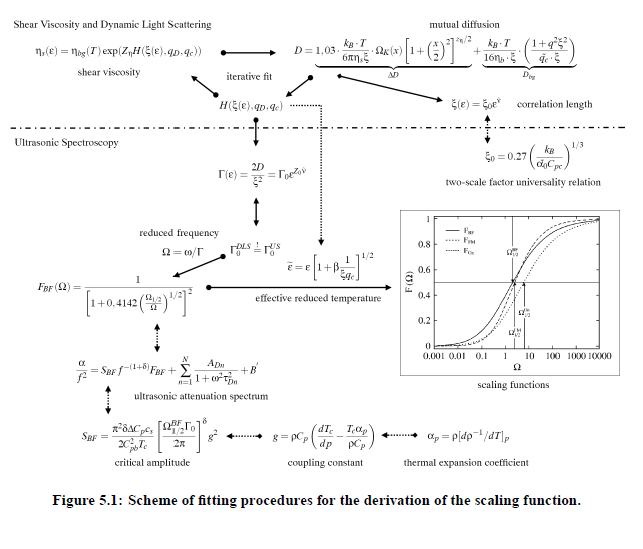2018-(I)-Critical Contribution, Dynamic Scaling and Crossover Theory
Article Index
Strategies of verifying the scaling function:
The formalism for the verification of the critical parameters and the scaling function calls for a specific treatment of experimental data within the framework of crossover formalisms as well as the Bhattacharjee-Ferrell theory of critical sound attenuation, Fig.(5.1). In principle, the scaling function can be derived directly from the ultrasonic measurements, by taking into account the Bhattacharjee-Ferrell theory. However, due to effects of critical slowing near T_c as well as the enormously increasing attenuation coefficient toward low frequencies, only the high frequency part of the critical contribution to the ultrasonic spectra is obtainable from attenuation coefficient measurements.Therefore Γ_US is only inaccurately known from acoustical spectrometry. For this reason and in order to reduce the number of unknown parameters in ultrasonic spectroscopy, the relaxation rate of order-parameter fluctuations has been additionally determined by shear viscosity and mutual diffusion coefficient measurements. Consequently, no distinction between the relaxation rate of critical fluctuations from ultrasonic measurements, Γ_US, and that from dynamic light scattering,Γ_DLS , will be made in the following:
This step is justified, because of the assumptions made by Bhattacharjee and Ferrell. According to their theory, local concentration fluctuations detected in the light scattering experiments are controlled by diffusion, of almost spherically shaped areas with concentration different from the mean. These fluctuating areas couple to the ultrasonic wave. Hence, the assumption for the characteristic relaxation rate Γ_DLS = Γ_US = Γ_0 can be done. In order to determine the characteristic relaxation rate Γ_0, dynamic light scattering and shear viscosity measurements have to be combined.
The Kawasaki-Ferrell relation can be rewritten to yield the relaxation rate of concentration fluctuations as a function of the diffusion coefficient and the shear viscosity:
The mutual diffusion coefficient as well as the fluctuation correlation length ξ can be derived from dynamic light scattering. However, crossover corrections have also to be taken into account. The crossover function H (ξ(ε),q_c ,q_D) contains an explicit dependence upon the fluctuation correlation length ξ and on the cut-off wave numbers qc and qD. Parameters ξ, qD and qc also control the mutual diffusion coefficient. Therefore, with the aid of an iterative fitting procedure the complicated expression of the crossover function H has to be applied simultaneously to the experimental shear viscosity and dynamic light scattering data. Finally,the value for Γ_0 determined in this way can be used to obtain the scaling function F (Ω). However, the critical amplitude is still an adjustable param eter. It weakly depends upon frequency due to the small critical exponent δ = α /(Z ν). If experimental heat capacity data are available, it is possible to calculate, with the amplitude SBF from thermodynamical quantities of critical mixture. Alternatively it is possible to extract the the amplitude from the ultrasonic spectra and to estimate the adiabatic coupling constant g. Furthermore, the amplitude of the correlation length ξ can be additionally verified with the help of heat capacity data using the so-called two-scale-factor universality relation:
with the heat critical exponent α0 = 0.11 and ∆ = 0.51 ± 0.03. However, as was mentioned in Section (4.4) the values for ξ0 and qc lead to noticeable changes of the reduced temperatures ε in the treatment of ultrasonic measurements. Hence, in the determination of the scaling function the reduced temperatures ε have to be corrected to get the effective reduced temperature ε . The fitting procedures applied on the basis of the dynamic scaling hypothesis and the crossover formalism are summarized schematically in Fig.(5.1).
- << Prev
- Next



